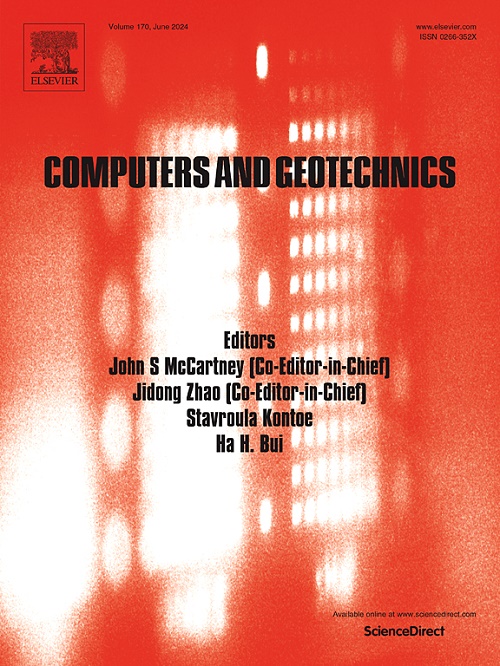A plasticity‑based upper‑bound prediction model incorporating shank effects for drag embedment anchor behavior in layered clay seabed
IF 6.2
1区 工程技术
Q1 COMPUTER SCIENCE, INTERDISCIPLINARY APPLICATIONS
引用次数: 0
Abstract
The installation of drag embedment anchors (DEAs) in layered seabeds presents significant challenges for predicting embedment trajectory and bearing capacity. This paper develops an analytical upper‑bound plasticity model that explicitly incorporates yield mechanisms of both fluke and shank, as well as transition zones between adjacent soil layers. The prediction model of anchor motion, rotation, and capacity are validated against full‑scale field tests in the Gulf of Mexico and Liuhua platform, as well as laboratory and numerical data for layered profiles in the South China Sea and Bass Strait. A comprehensive parametric study is conducted to assess the influence of stiff‑layer strength ratio, layer thickness, and fluke–shank angle on the ultimate embedment depth and load capacity. Key findings include: (1) a critical strength ratio (≈7.45) beyond which penetration fails; (2) while layer thickness does not control penetrability, it linearly increases ultimate embedment depth when the stiff layer is penetrable and moderately thick; and (3) an optimal fluke-shank angle exists that balances tip stress concentration for penetration with adequate bearing area for capacity. These findings provide practical design guidance for the effective deployment of DEAs in stratified seabed.
基于塑性的层状粘土海底拖曳锚杆性能上界预测模型
在层状海床中安装拖曳预埋锚(dea)对预埋轨迹和承载能力的预测提出了重大挑战。本文开发了一个解析性上限塑性模型,该模型明确地结合了吸片和柄的屈服机制,以及相邻土层之间的过渡区。通过墨西哥湾和流花平台的全尺寸现场试验,以及南海和巴斯海峡分层剖面的实验室和数值数据,验证了锚运动、旋转和能力的预测模型。通过综合参数研究,评估了刚性层强度比、层厚度和爪柄角对极限埋深和承载能力的影响。主要发现包括:(1)超过临界强度比(su,ratio≈7.45),侵彻就会失效;(2)层厚不控制穿透性,但当刚性层可穿透且厚度适中时,层厚线性增加了最终嵌入深度;(3)存在一个最优的爪柄角,既能平衡突防尖端应力集中,又有足够的承载面积。这些研究结果为分层海床上dea的有效部署提供了实用的设计指导。
本文章由计算机程序翻译,如有差异,请以英文原文为准。
求助全文
约1分钟内获得全文
求助全文
来源期刊

Computers and Geotechnics
地学-地球科学综合
CiteScore
9.10
自引率
15.10%
发文量
438
审稿时长
45 days
期刊介绍:
The use of computers is firmly established in geotechnical engineering and continues to grow rapidly in both engineering practice and academe. The development of advanced numerical techniques and constitutive modeling, in conjunction with rapid developments in computer hardware, enables problems to be tackled that were unthinkable even a few years ago. Computers and Geotechnics provides an up-to-date reference for engineers and researchers engaged in computer aided analysis and research in geotechnical engineering. The journal is intended for an expeditious dissemination of advanced computer applications across a broad range of geotechnical topics. Contributions on advances in numerical algorithms, computer implementation of new constitutive models and probabilistic methods are especially encouraged.
 求助内容:
求助内容: 应助结果提醒方式:
应助结果提醒方式:


